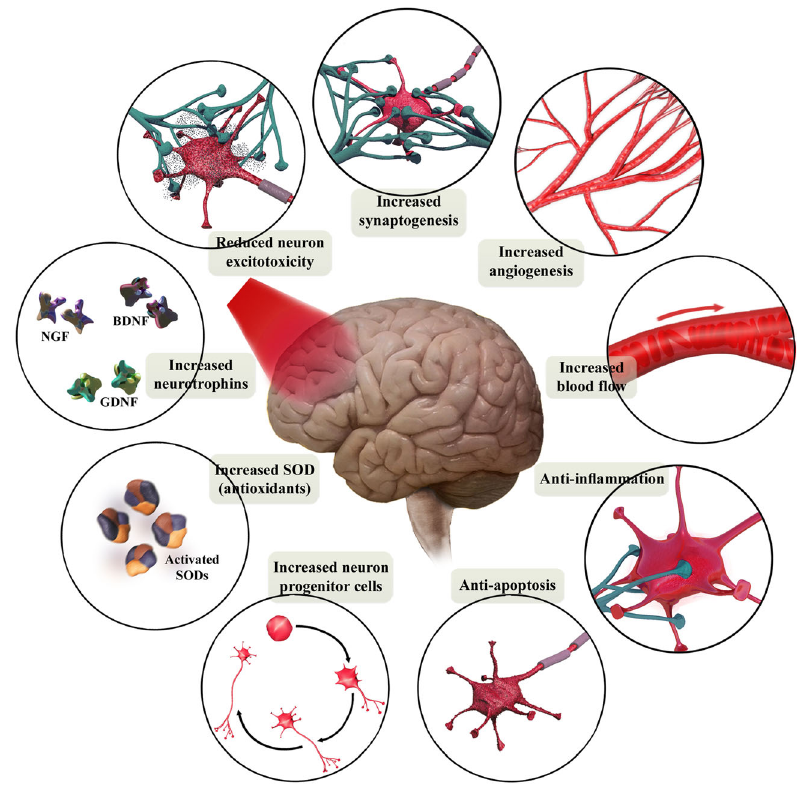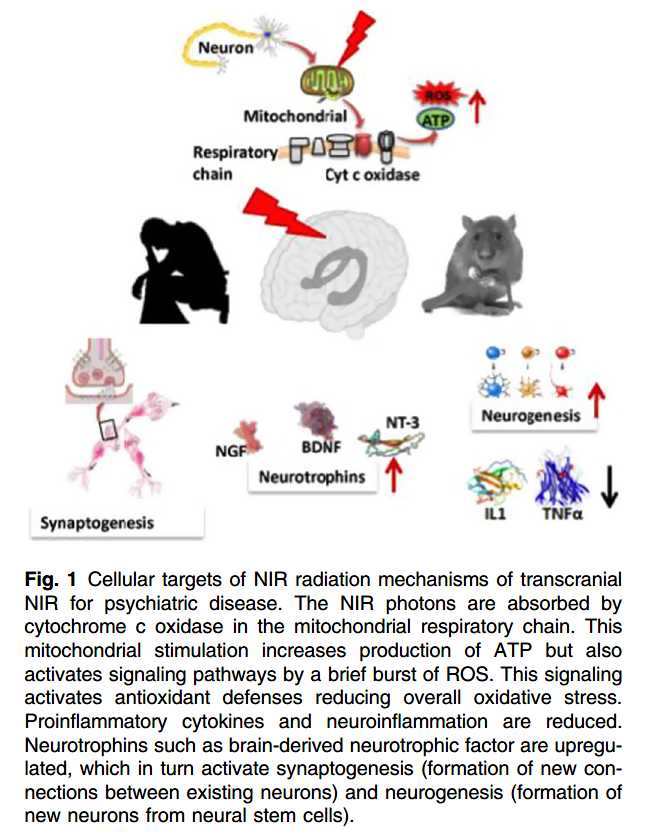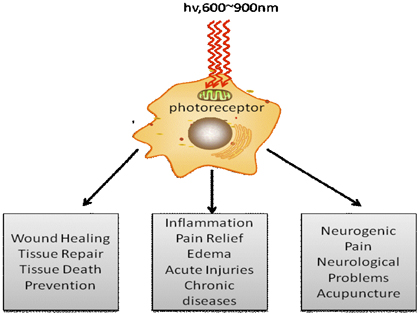 |

|
| Photoneurobiomodulatie: |
 |
|
Transcraniële photobiomodulatie stimuleert de mitochondriën in de celkernen van de hersencellen, leidend tot een toename van het energie metabolisme in de hersenen. Bovendien worden cellulaire transcriptie factoren en genexpressie geactiveerd. Daarnaast verhoogt de hersendoorbloeding, en bevordert deze photoneurobiomodulatie neuronale bescherming en overleving, door verhoogde antioxidant responsen, een anti-inflammatoire werking en de stimulatie van neurotrope factoren. Photoneurobiomodulatie leidt ook tot neurogenese en synaptogenese (ontstaan van nieuwe hersencellen en nieuwe synapsen/contacten tussen hersencellen). |
 |
|
Op gedragsniveau blijkt uit recent onderzoek dat deze vorm van neurotherapie gunstige klinische effecten heeft bij hersentrauma patiënten (zowel TBI als CVA), depressie, slaap, dementie en cognitieve verbetering in het algemeen. |
 |
Wetenschappelijke artikels over de effecten van photoneurobiomodulatie bij patiënten:
Barrett, D.W. & Gonzalez-Lima, F. (2013). Transcranial infrared laser stimulation produces beneficial cognitive and emotional effects in humans. Neuroscience, 230, 13–23.
Blanco, N.J., Maddox, W.T., & Gonzalez-Lima, F.(2017). Improving executive function using transcranial infrared laser stimulation. J Neuropsychol., 11(1), 14–25. doi:10.1111/jnp.12074
Caldieraro, M.A., & Cassano, P. (2019). Transcranial and Systemic Photobiomodulation for Major Depressive Disorder: A Systematic Review of Efficacy, Tolerability and Biological Mechanisms. Journal of Affective Disorders, vol. 243, 262-273.
Caldieraro, M.A., Sani, G., Bui, E., Cassano, P. (2018). Long-Term Near-Infrared Photobiomodulation for Anxious Depression Complicated by Takotsubo Cardiomyopathy. Journal of Clinical Psychopharmacology, vol. 38(3), pp. 268–270.
Cassano, P., Cusin, C., Mischoulon, D., Hamblin, M.R., De Taboada, Pisoni, A., Chang, T., Yeung, A., Ionescu, D.F., Petrie, S.R., Nierenberg, A.A., Fava, M., Iosifescu, D.V. (2015). Near-Infrared Transcranial Radiation for Major Depressive Disorder: Proof of Concept Study. Psychiatry Journal, Volume 2015, Article ID 352979, 8 pages, http://dx.doi.org/10.1155/2015/352979
Cassano, P., Petrie, S.R., Hamblin, M.R., Henderson, T.A., Iosifescu, D.V. (2016). Review of transcranial photobiomodulation for major depressive disorder: targeting brain metabolism, inflammation, oxidative stress, and neurogenesis. Neurophotonics, vol. 3(3), pp. 031404. doi: 10.1117/1.NPh.3.3.031404
Chang, J., Ren, Y., Wang, R., Li, C., Wang, Y., Chu, X-P. (2018). Transcranial Low-Level Laser Therapy for Depression and Alzheimer’s Disease. Neuropsychiatry, 8(2), 477–483.
de la Torre, J.C. (2017). Treating cognitive impairment with transcranial low level laser therapy. J. Photochem. Photobiol B 168(1), 149-155.
Disner, S.G., Beevers, C.G., & F. Gonzalez-Lima (2016). Transcranial Laser Stimulation as Neuroenhancement for Attention Bias Modification in Adults with Elevated Depression Symptoms. Brain Stimulation, 9(5), 780–787.
Dos Santos, JGRP, Paiva, WS, & Teixeira, MJ (2018). Transcranial light-emitting diode therapy for neuropsychological improvement after traumatic brain injury: a new perspective for diffuse axonal lesion management. Medical Devices: Evidence and Research, 11, 139-146. doi: 10.2147/MDER.S155356
Hacke, W., Schellinger, P.D., Albers, G.W. et al. (2014). Transcranial laser therapy in acute stroke treatment: results of neurothera effectiveness and safety trial 3, a phase III clinical end point device trial. Stroke, vol. 45(11), pp. 3187–3193.
Hamblin, M.R. (2018). Photobiomodulation for traumatic brain injury and stroke. Journal of Neuroscience Research, 96:731–743.
Hamblin, M.R. (2016). Shining light on the head: Photobiomodulation for brain disorders. BBA Clin., 6,:113-124.
Henderson, T.A. & Morries, L.D. (2017). Multi-Watt Near-Infrared Phototherapy for the Treatment of Comorbid Depression: An Open-Label Single-Arm Study. Frontiers in Psychiatry, vol.8, art. 187, doi: 10.3389/fpsyt.2017.00187
Henderson, T.A., & Morries, L.D. (2015). SPECT perfusion imaging demonstrates improvement of traumatic brain injury with transcranial near-infrared laser phototherapy. Advances in Mind-Body Medicine, 29(4), 27-33.
Henderson TA, Morries LD (2015). Near-infrared photonic energy penetration: can infrared phototherapy effectively reach the human brain? Neuropsychiatr. Dis. Treat 11(1), 2191-2208.
Hennessy, M., & Hamblin, M.R. (2016). Photobiomodulation and the brain: a new paradigm. Journal of Optics, vol. 19(1), pp. 013003.
Huisa, B.N., Stemer, A.B., Walker, M.G., Rapp, K., Meyer, B.C., & Zivin, J.A. (2013). Transcranial laser therapy for acute ischemic stroke: a pooled analysis of NEST-1 and NEST-2. International Journal of Stroke, vol. 8(5), pp. 315–320.
Johnstone, D. M., Moro, C., Stone, J., Benabid, A. L. & Mitrofanis, J. (2015). Turning On Lights to Stop Neurodegeneration: The Potential of Near Infrared Light Therapy in Alzheimer’s and Parkinson’s Disease. Front Neurosci 9, 500, doi:10.3389/fnins.2015.00500
Lampl, Y., Zivin, J.A., Fisher, M. et al. (2007). Infrared laser therapy for ischemic stroke: a new treatment strategy. Results of the NeuroThera Effectiveness and Safety Trial-1 (NEST-1). Stroke, 38(6), pp. 1843–1849.
Lapchak, P. A. & Boitano, P. D. (2016). Transcranial Near-Infrared Laser Therapy for Stroke: How to Recover from Futility in the NEST-3 Clinical Trial. Acta Neurochir Suppl 121, 7-12, doi:10.1007/978-3-319-18497-5_2
Morries, L.D., Cassano, P., & T.A. Henderson (2015). Treatments for traumatic brain injury with emphasis on transcranial near-infrared laser phototherapy. Neuropsychiatr. Dis. Treat., 11(1), 2159–2175.
Naeser, M. A. & Hamblin, M. R. (2015). Traumatic Brain Injury: A Major Medical Problem That Could Be Treated Using Transcranial, Red/Near-Infrared LED Photobiomodulation. Photomed Laser Surg, 33(9),, 443-446. doi:10.1089/pho.2015.3986
Naeser MA, & Hamblin MR (2011). Potential for transcranial laser or LED therapy to treat stroke, traumatic brain injury, and neurodegenerative disease. Photomed. Laser Surg., 29(7), 443-446.
Naeser, M.A., Martin, P.I., Ho, M.D., Krengel, M.H., Bogdanova, Y., Knight, J.A., Yee, M.K., Zafonte, R., Frazier, J., Hamblin, M.R., Koo, B.-B. (2016). Transcranial, Red/Near-Infrared Light-Emitting Diode Therapy to Improve Cognition in Chronic Traumatic Brain Injury. Photomedicine and Laser Surgery, Vol. 34 (12), 610–626.
Naeser, M.A., Saltmarche, A., Krengel, M.H., Hamblin, M.R., & J.A. Knight (2011). Improved cognitive function after transcranial, light-emitting diode treatments in chronic, traumatic brain injury: two case reports. Photomedicine and Laser Surgery, 29(5), pp. 351–358.
Naeser, M.A., Zafonte, R., Krengel, M.H. et al. (2014). Significant improvements in cognitive performance post-transcranial, red/near-infrared light-emitting diode treatments in chronic, mild traumatic brain Injury: open-protocol study. Journal of Neurotrauma, 31(11), pp. 1008–1017.
Rojas, J.C., & F. Gonzalez-Lima (2013). Neurological and psychological applications of transcranial lasers and LEDs. Biochemical Pharmacology, 86, 447–457.
Salehpour, F., Mahmoudi, J., Kamari, F., Sadigh-Eteghad, S., Rasta, S.H., Hamblin, M.R. (2018). Brain Photobiomodulation Therapy: a Narrative Review. Molecular Neurobiology, 55(8):6601-6636. doi: 10.1007/s12035-017-0852-4
Salehpour, F., & S.H. Rasta (2017). The potential of transcranial photobiomodulation therapy for treatment of major depressive disorder. Reviews in the Neurosciences, 28(4), Pages 441–453. DOI: https://doi.org/10.1515/revneuro-2016-0087
Salgado SIA, Parreira RB, Ceci LA, de Oliveira LVF, Zangaro RA (2015). Transcranial Light Emitting Diode Therapy (TCLT) and its Effects on Neurological Disorders. J Bioengineer & Biomedical Sci 5: 144. doi:10.4172/2155-9538.1000144
Saltmarche, A.E., Naeser, M.A., Ho, K.F., Hamblin, M.R., & Lim, L. (2017). Significant Improvement in Cognition in Mild to Moderately Severe Dementia Cases Treated with Transcranial Plus Intranasal Photobiomodulation: Case Series Report. Photomedicine and Laser Surgery, 35(8):432-441.
Schiffer, F., Johnston, A.L., Ravichandran, C., Polcari, A., Teicher, M.H., Webb, R.H., & Hamblin, M.R. (2009). Psychological benefits 2 and 4 weeks after a single treatment with near infrared light to the forehead: a pilot study of 10 patients with major depression and anxiety. Behavioral and Brain Functions, 5, 46.
Tedford, C. E., DeLapp, S., Jacques, S. & Anders, J. (2015). Quantitative analysis of transcranial and intraparenchymal light penetration in human cadaver brain tissue. Lasers in surgery and medicine 47(4), 312-322, doi:10.1002/lsm.22343
Thunshelle, C. & Hamblin, M. R. (2016). Transcranial low-level laser (light) therapy for brain injury. Photomed Laser Surg 34(12): 587-598. doi: 10.1089/pho.2015.4051
|


|
|
|
|
